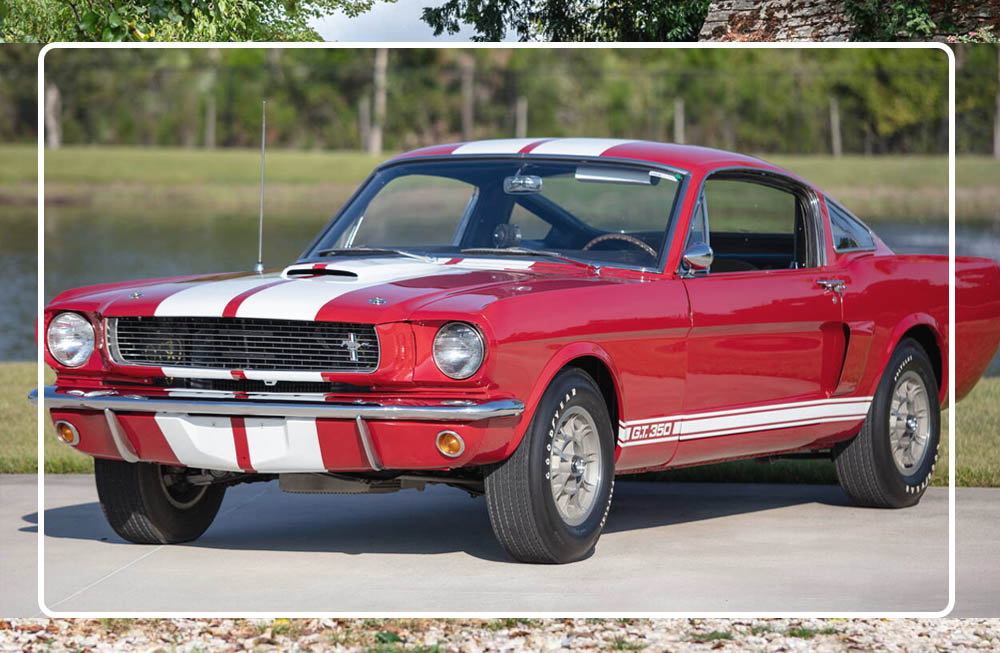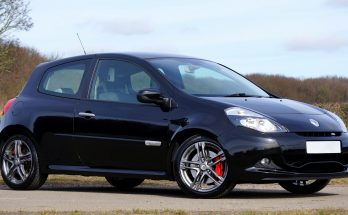
The 1966 Shelby Mustang GT350 was the second iteration of Carroll Shelby’s high-performance variant of the Ford Mustang. It retained much of the raw racing character of the 1965 model but was slightly refined for a broader market appeal. This year also marked the introduction of the GT350H “Rent-a-Racer,” a collaboration with Hertz, making the Shelby Mustang more accessible to enthusiasts.
Overview of Shelby GT350
| Feature | Details |
|---|---|
| Production Year | 1966 |
| Manufacturer | Shelby American (in partnership with Ford) |
| Body Style | Fastback |
| Total Production | 2,378 units |
| Market Impact | Expanded market appeal; solidified Shelby’s performance legacy |
Engine Specs and Features
| Feature | Details |
|---|---|
| Engine Type | 289 cubic inch (4.7L) V8, “K-code” Hi-Po |
| Horsepower | 306 hp @ 6,000 rpm |
| Torque | 329 lb-ft @ 4,200 rpm |
| Compression Ratio | 10.5:1 |
| Carburetor | Holley 715 CFM 4-barrel |
| Transmission | 4-speed manual or optional 3-speed automatic |
| Exhaust System | Dual side-exit exhaust (early models) |
| Drive Type | Rear-wheel drive (RWD) |
Performance
| Feature | Details |
|---|---|
| 0-60 MPH | ~6.5 seconds |
| Quarter Mile | ~15 seconds |
| Top Speed | ~130 mph |
| Suspension | Modified for track use (stiffer springs, larger sway bars) |
| Brakes | Front disc brakes, rear drum brakes |
Fuel & MPG
| Feature | Details |
|---|---|
| Fuel Type | Premium gasoline |
| Fuel Tank Capacity | 16 gallons |
| MPG | ~10-15 mpg (performance-oriented driving) |
Dimensions
| Feature | Details |
|---|---|
| Length | 181.6 inches |
| Width | 68.2 inches |
| Height | 51.0 inches |
| Wheelbase | 108 inches |
| Curb Weight | ~2,900 pounds |
Safety Features
| Feature | Details |
|---|---|
| Brakes | Front disc brakes (standard), rear drum brakes |
| Seat Belts | Lap belts (standard) |
| Body Construction | Reinforced unibody |
| Lighting | Sealed-beam headlights |
| Roll Bar | Included in competition models |
1966 Shelby Mustang Interior Features
| Feature | Details |
|---|---|
| Seating Capacity | 2 passengers (rear seat delete for weight savings) |
| Upholstery | Black vinyl |
| Dashboard | Simple, driver-focused layout |
| Gauges | Tachometer and speedometer prominently displayed |
| Steering Wheel | Wood-rimmed 3-spoke Shelby design |
| Floor Mats | Shelby-branded (optional) |
| Roll Bar | Standard in some models |
Exterior Features of 1966 Shelby Mustang
| Feature | Details |
|---|---|
| Body Style | Fastback |
| Paint | Wimbledon White with blue Le Mans racing stripes (standard); optional colors introduced |
| Hood Design | Fiberglass with functional scoop |
| Badging | “GT350” emblems and Shelby Cobra logo |
| Wheels | 15-inch steel or Magnum 500 wheels |
| Windows | Manual crank-operated |
| Additional Features | Functional side vents, lightweight aluminum panels |
GT350H “Rent-a-Racer”
| Feature | Details |
|---|---|
| Production | 1,001 units built for Hertz |
| Unique Features | Black with gold stripes, automatic transmission optional |
| Purpose | Allow customers to “rent” a Shelby for weekend driving or racing |
Current Price in U.S.
| Condition | Price Range |
|---|---|
| Excellent (Restored) | $350,000 – $500,000 |
| Good (Well-maintained) | $200,000 – $350,000 |
| Fair (Functional but Worn) | $125,000 – $200,000 |
| Poor (Needs Restoration) | $75,000 – $125,000 |
The Evolution of the 1966 Shelby GT350: A Turning Point in American Muscle Car History
The 1966 Shelby GT350 maintained the raw performance DNA of the 1965 model while becoming more user-friendly. With features like an optional automatic transmission and additional color choices, it broadened its appeal. The GT350H further popularized the brand through its innovative Hertz collaboration. Today, the 1966 GT350 remains a highly desirable classic car, celebrated for its blend of performance, rarity, and Shelby heritage.
When the conversation turns to American muscle cars, Shelby consistently roars to the forefront. Among Carroll Shelby’s most legendary creations, the 1966 Shelby GT350 holds a pivotal place in both Mustang and muscle car history. It was more than just a fast car; it became a powerful symbol of performance, groundbreaking innovation, and the audacious spirit of Carroll Shelby himself.
In this detailed article, we’ll explore the remarkable evolution of the 1966 Shelby GT350—how it transformed from a raw, track-focused machine into a more polished performance legend, expertly blending exhilarating track capability with enhanced road comfort. Whether you’re a dedicated collector, an automotive historian, or a devoted Shelby enthusiast, buckle up for a high-octane journey through automotive history.
The Genesis: Understanding the 1965 GT350
To fully appreciate the evolution of the 1966 GT350, it’s essential to look back at its origins.
The 1965 Shelby GT350 was a no-compromise, purpose-built track car, specifically designed to dominate the Sports Car Club of America (SCCA) B-Production racing series. Based on the Ford Mustang Fastback, Carroll Shelby meticulously transformed the standard Mustang into a lightweight, high-performance racing machine featuring:
- A potent 289 cubic-inch Hi-Po V8 engine, delivering an impressive 306 horsepower.
- Significantly upgraded suspension and brakes, alongside a robust Borg-Warner T10 4-speed transmission.
- A stripped-down interior with minimal amenities, emphasizing its racing intent.
- Aggressive side-exit exhausts and the iconic Wimbledon White paint with Guardsman Blue stripes.
The 1965 GT350 was exhilarating to drive—but it was also raw, incredibly loud, and unforgiving, clearly engineered for the racetrack rather than daily commutes.
Why Evolution Was Essential: The 1966 Shelby GT350’s Purpose
While the 1965 GT350 captured the hearts of racing enthusiasts, its extreme, uncompromising nature wasn’t ideal for the broader Mustang market. Ford and Shelby quickly recognized that to broaden its appeal and increase sales volume, they needed to “civilize the beast” without sacrificing its thrilling performance.
This realization led to the 1966 Shelby GT350—a model year that struck a near-perfect balance between its aggressive racing heritage and real-world usability.
Key Enhancements: What Made the 1966 Shelby GT350 Different
The 1966 model year brought significant updates designed to make the GT350 more appealing to a wider audience, all while retaining its formidable performance edge.
1. Cosmetic Enhancements for Broader Appeal:
- The non-functional rear quarter panel vents of the 1965 model were replaced with functional rear quarter windows, dramatically improving rear visibility.
- The fuel cap proudly displayed the iconic Shelby logo, complemented by new GT350 badging throughout the vehicle.
- For the first time, buyers had a wider array of exterior colors beyond Wimbledon White, including vibrant Candy Apple Red, sophisticated Sapphire Blue, classic Ivy Green, and sleek Raven Black.
- The signature Le Mans racing stripes became optional, allowing for a more understated look for street-oriented buyers.
2. Enhanced Interior Comforts:
The spartan, race-focused interior of the 1965 GT350 was softened significantly for 1966:
- The most notable addition was full rear seats, officially making the GT350 a true 2+2 coupe capable of carrying more than just two occupants.
- Optional amenities like AM radios, increased sound insulation, and improved interior trim were added to enhance the driving experience.
- Basic features like sun visors were standardized, aligning the GT350 more closely with expectations for a comfortable road car.
These changes transformed the 1966 Shelby GT350 into a performance car that could genuinely be enjoyed for daily driving.
3. Refined Mechanicals: Performance with Polish:
While the core powertrain remained unchanged, delivering that potent 289 cu in V8 engine rated at 306 horsepower and mated to a 4-speed manual transmission with performance-tuned suspension and front disc brakes, several crucial tweaks made the 1966 GT350 more user-friendly:
- A rear traction bar (also known as an underride bar) was strategically added to minimize frustrating axle hop under hard acceleration, improving driveability.
- The exhaust routing was cleverly moved to rear-exit pipes, significantly reducing cabin noise and the issue of fumes entering the interior—a major comfort improvement for road use.
4. The Legendary GT350H: The “Rent-A-Racer” Program:
One of the most iconic moves in Shelby history unfolded in 1966 with the introduction of the GT350H model. This special version of the GT350 was specifically built for the Hertz Corporation’s Rent-A-Car program.
These distinctive black-and-gold beasts allowed everyday customers to rent a genuine Shelby Mustang for a thrilling weekend. Though many were famously returned with “racing scars” (and bald tires), the GT350H program incredibly boosted the Shelby brand’s profile in mainstream pop culture.
Production Numbers & Rarity: Scaling Up Performance
The production figures for the 1966 Shelby GT350 demonstrate Shelby’s intent to broaden its market reach while maintaining exclusivity:
- Total 1966 Shelby GT350 production:2,378 units
- 1,365 were standard fastbacks for public sale.
- 936 were the distinctive Hertz GT350H models.
- 252 were “carryover” cars (essentially leftover 1965 models that were modified to 1966 specifications).
While these numbers appear small by mass-production standards, they represent a substantial increase from the mere 562 units built in 1965, underscoring Shelby’s strategic pivot towards greater accessibility.
1966 Shelby GT350 Performance Specifications Recap:
| Feature | 1966 Shelby GT350 |
| Engine | 289 cu in (4.7L) Hi-Po V8 |
| Horsepower | 306 hp @ 6,000 rpm |
| Torque | 329 lb-ft @ 4,200 rpm |
| 0-60 mph | ~6.6 seconds |
| Top Speed | ~130 mph |
| Transmission | 4-speed manual |
| Brakes | Front discs, rear drums |
| Curb Weight | ~2,800 lbs. |



